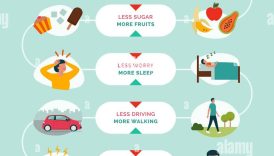Forever Fit: Tips for Sustaining a Healthy Lifestyle for Life

Living a healthy lifestyle is not just a trend; it’s a fundamental aspect of overall well-being. Many people understand the importance of staying fit and eating right, yet they struggle to implement these changes consistently.
- Forever Fit: Tips for Sustaining a Healthy Lifestyle for Life
- Embracing Healthy Living
- Importance of Sustaining a Healthy Lifestyle
- Long-term Benefits
- Benefits of Regular Exercise
- Physical Health
- Mental Health
- Nutritious Diet for Long-Term Wellness
- Importance of Balanced Meals
- Superfoods to Include in Your Diet
- Prioritizing Mental Well-being
- Stress Management Techniques
- Importance of Adequate Sleep
- Consistency in Healthy Habits
- Setting Realistic Goals
- Building a Support System
- Incorporating Physical Activity into Daily Routine
- Exercise Ideas for Busy Schedules
- Benefits of Strength Training
- Mindful Eating Practices
- Strategies for Portion Control
- Eating with Awareness
- Hydration for Overall Health
- Importance of Drinking Enough Water
- Benefits of Herbal Teas
- Creating a Sustainable Exercise Routine
- Finding Activities You Enjoy
- Tips for Staying Motivated
- Balancing Work and Personal Life
- Time Management Strategies
- Importance of Work-Life Balance
- Regular Health Check-ups and Screenings
- Preventive Healthcare Measures
- Importance of Early Detection
- Avoiding Harmful Habits
- Effects of Smoking and Excessive Alcohol Consumption
- Strategies for Quitting Unhealthy Behaviors
- Longevity and Quality of Life
- Healthy Aging Tips
- Benefits of a Positive Outlook
- Conclusion
- The Path Forward
Embracing Healthy Living
Consider Jane, who made the shift from a sedentary lifestyle to incorporating regular exercise and nutritious meals. Within months, she felt more energetic and happier, demonstrating the transformative power of these choices. In this blog, we will explore:
- The significance of maintaining a healthy lifestyle
- Benefits of regular exercise and a balanced diet
- Prioritizing mental well-being and hydration
Join us as we uncover practical strategies for cultivating habits that foster long-term wellness!
Importance of Sustaining a Healthy Lifestyle
Building on the idea of transforming one’s life, understanding the importance of sustaining a healthy lifestyle can provide the motivation needed for meaningful change. A consistent commitment to health not only enhances physical appearance but also improves overall quality of life.
Long-term Benefits
Take Michael, for instance, who decided to make small changes each day. Over the years, these modifications led to:
- Increased energy levels: He found it easier to keep up with his kids.
- Better mood stability: Regular exercise helped alleviate his stress.
- Stronger immunity: He noticed fewer sick days.
Sustaining a healthy lifestyle creates a foundation for emotional resilience and improved physical health, ultimately leading to a more fulfilling life.
Benefits of Regular Exercise
With a solid understanding of the importance of sustaining a healthy lifestyle, let’s delve into one of its core pillars: regular exercise. Engaging in physical activity isn’t just about fitting into those jeans; it has profound benefits for both physical and mental health.
Physical Health
Exercise plays a vital role in maintaining overall physical well-being. For example, Lisa started jogging three times a week and experienced:
- Weight management: She shed extra pounds effortlessly.
- Improved cardiovascular health: Her heart began to function more efficiently.
- Increased muscle strength: Everyday tasks became easier.
Mental Health
Physical activity also significantly boosts mental health. Mark, who incorporated workout sessions into his routine, noticed:
- Enhanced mood: Exercise releases endorphins, which are natural mood lifters.
- Reduction in anxiety: Regular movement helped him manage daily stressors.
- Better sleep quality: He began to fall asleep faster and sleep deeper.
Ultimately, the benefits of regular exercise create a well-rounded approach to personal wellness, promoting both body and mind in harmony.
Nutritious Diet for Long-Term Wellness
Having established the benefits of regular exercise, let’s now turn our attention to another vital aspect of a healthy lifestyle—a nutritious diet. What we consume greatly impacts our health, energy levels, and overall well-being.
Importance of Balanced Meals
Balanced meals play a crucial role in fueling our bodies effectively. For instance, Sarah learned that incorporating various food groups in her meals helped her feel more satisfied and energized throughout the day. A balanced meal typically includes:
- Proteins: Essential for muscle repair and growth.
- Carbohydrates: The body’s main energy source.
- Healthy fats: Important for brain health and hormone production.
- Fruits and vegetables: Packed with vitamins, minerals, and antioxidants.
Superfoods to Include in Your Diet
In addition to balanced meals, adding superfoods can further enhance nutritional intake. Some of Sarah’s favorites include:
- Quinoa: A complete protein rich in amino acids.
- Blueberries: Known for their antioxidant properties.
- Kale: A nutrient-dense leafy green high in vitamins K and C.
By prioritizing a nutritious diet filled with balanced meals and superfoods, individuals set a strong foundation for long-term wellness and vitality.
Prioritizing Mental Well-being
Having explored a nutritious diet, it’s equally essential to focus on mental well-being for a truly healthy lifestyle. With the hustle and bustle of everyday life, prioritizing mental health has never been more critical.
Stress Management Techniques
Effective stress management is vital for maintaining mental clarity and emotional balance. For instance, Emma found that practicing mindfulness and deep-breathing exercises made a noticeable difference in her day-to-day stress levels. Some techniques to consider include:
- Meditation: A few minutes daily can help clear the mind.
- Regular physical activity: Helps reduce stress hormones.
- Journaling: Writing about feelings can provide clarity.
Importance of Adequate Sleep
Another crucial factor is getting adequate sleep. Jake realized that a consistent sleep schedule transformed his mood and productivity. Key benefits of quality sleep include:
- Improved cognitive function: Better focus and decision-making.
- Enhanced emotional stability: Reduced irritability and anxiety.
- Physical restoration: Helps the body recover and recharge.
By incorporating stress management techniques and ensuring sufficient sleep, individuals can bolster their mental well-being, leading to greater overall life satisfaction.
Consistency in Healthy Habits
Now that we’ve established the importance of mental well-being, it’s time to discuss another cornerstone of a healthy lifestyle: consistency in healthy habits. Sticking to positive changes can be challenging, but a few strategies can make the journey more manageable.
Setting Realistic Goals
Setting achievable goals is essential for maintaining motivation. When Mark first started his fitness journey, he aimed too high and felt discouraged. By breaking his goals into smaller, manageable steps, he experienced success and built momentum. Consider these tips for setting realistic goals:
- Start small: Focus on one habit at a time.
- Measure progress: Use charts or apps to track achievements.
- Celebrate milestones: Reward yourself when you hit a goal, no matter how small.
Building a Support System
Having a support system also enhances consistency. Lisa joined a local hiking group, which not only made exercising fun but also offered accountability. Strong support systems can include:
- Friends and family: Share your goals with them for encouragement.
- Community groups: Find local organizations or online forums with similar interests.
- Fitness partners: Train with someone who shares your health goals.
By setting realistic goals and surrounding yourself with supportive people, maintaining healthy habits becomes a fulfilling and achievable part of daily life.
Incorporating Physical Activity into Daily Routine
With consistency in healthy habits established, let’s explore how to weave physical activity into even the busiest of schedules. Finding time to exercise can feel daunting, but there are creative ways to stay active without overhauling your entire day.
Exercise Ideas for Busy Schedules
Consider Mia, a full-time professional and parent, who discovered clever ways to add exercise into her day. Here are some practical ideas:
- Morning stretches: Start your day with a 10-minute stretch routine.
- Walking meetings: Suggest a stroll instead of sitting in a conference room.
- Active family time: Plan weekend outings that involve hiking or biking.
Benefits of Strength Training
Incorporating strength training into your routine offers a wealth of benefits. Like Alex, who dedicated just 20 minutes twice a week to weight training, you can reap advantages such as:
- Increased muscle mass: Supports metabolic rate and helps with weight management.
- Bone health: Strengthens bones and reduces the risk of osteoporosis.
- Enhanced mood: Releases endorphins that boost mental well-being.
By finding ways to integrate physical activity into daily life and prioritizing strength training, individuals can create a balanced approach to fitness, making it an attainable and enjoyable aspect of their routine.
Mindful Eating Practices
As we continue our journey toward a balanced lifestyle, it’s essential to explore mindful eating practices. Just as we prioritize physical activity, being intentional about what and how we eat can greatly enhance our overall health and well-being.
Strategies for Portion Control
One of the key components of mindful eating is mastering portion control. Maria discovered that by using smaller plates, she naturally reduced her serving sizes without feeling deprived. Here are some effective strategies for portion control:
- Visual cues: Use your hand—protein portion equals a palm, carbs a fist, and veggies a cup.
- Pre-portion snacks: Pack single servings to prevent overeating.
- Mindful plating: Serve food in the kitchen instead of on the dining table.
Eating with Awareness
Eating with awareness means truly savoring each bite and being present during meals. For example, when Jake decided to put away his phone during lunch, he found he enjoyed his food more and felt satisfied sooner. To practice mindful eating:
- Slow down: Take time to chew thoroughly and appreciate flavors.
- Limit distractions: Turn off the TV and focus on the meal.
- Reflect on hunger cues: Ask yourself if you’re truly hungry or eating out of habit.
By integrating these mindful eating practices into daily routines, individuals can cultivate a more satisfying and healthier relationship with food.
Hydration for Overall Health
Continuing from our exploration of mindful eating practices, we must address another vital component of a healthy lifestyle: hydration. Proper hydration is essential for bodily functions and overall well-being.
Importance of Drinking Enough Water
Jessica, who often overlooked her water intake, learned that staying hydrated significantly impacted her energy levels and digestion. The general recommendation is about eight 8-ounce glasses a day, but individual needs can vary. Consider these benefits of drinking enough water:
- Boosts metabolism: Optimizes calorie burning.
- Supports digestion: Prevents constipation and aids nutrient absorption.
- Regulates body temperature: Helps maintain steady temperature during physical activities.
Benefits of Herbal Teas
In addition to water, herbal teas are a delightful and beneficial way to stay hydrated. Tom started incorporating herbal teas into his routine and noticed a calming effect. Some benefits include:
- Antioxidants: Many herbal teas are rich in antioxidants, helping combat oxidative stress.
- Soothing properties: Teas like chamomile and peppermint promote relaxation and digestion.
- Variety in flavor: Exploring different herbal blends can make hydration more enjoyable.
By prioritizing hydration through both water and herbal teas, individuals can enhance their health and boost their vitality throughout the day.
Creating a Sustainable Exercise Routine
As we wrap up our discussion on hydration, it’s time to explore how to create a sustainable exercise routine that fits seamlessly into your lifestyle. A consistent workout plan can significantly improve your overall health, and finding ways to make it enjoyable is key.
Finding Activities You Enjoy
Jessica found that experimenting with different activities helped her discover what she truly enjoyed. Instead of forcing herself to run daily, she tried various options, including:
- Dance classes: Fun and energetic, she loved the rhythm.
- Yoga: Great for flexibility and relaxation.
- Hiking: Connecting with nature made exercise feel less like a chore.
Tips for Staying Motivated
Staying motivated can be challenging, but establishing a few strategies can help keep the enthusiasm alive. For example, Mike started tracking his progress and set small goals, celebrating milestones along the way. Consider these tips:
- Mix it up: Change routines to keep things fresh.
- Workout buddies: Exercising with friends adds accountability and fun.
- Reward yourself: Treat yourself to new workout gear for reaching a goal.
By finding enjoyable activities and employing motivational tips, individuals can develop a sustainable exercise routine that brings joy and lasting benefits.
Balancing Work and Personal Life
Having established the importance of a sustainable exercise routine, let’s shift our focus to another critical aspect of overall wellness: balancing work and personal life. In today’s fast-paced world, achieving this balance can be challenging yet vital for maintaining mental and emotional health.
Time Management Strategies
Sophia used to feel overwhelmed by her workload, but she discovered effective time management strategies that transformed her daily routine. Here are some techniques she found helpful:
- Prioritize tasks: Use the Eisenhower Matrix to distinguish between urgent and important tasks.
- Set boundaries: Designate specific work hours and stick to them.
- Pomodoro Technique: Work in focused bursts of 25 minutes followed by a 5-minute break.
Importance of Work-Life Balance
Maintaining a healthy work-life balance is crucial for long-term satisfaction and productivity. Daniel realized that overworking led to burnout, prompting him to focus on balance. Key benefits include:
- Improved mental health: Reduces stress and anxiety levels.
- Enhanced productivity: Well-rested individuals tend to perform better.
- Stronger relationships: More time for family and friends enriches personal connections.
By effectively managing time and recognizing the significance of work-life balance, individuals can nurture their overall well-being and lead a more fulfilling life.
Regular Health Check-ups and Screenings
Now that we’ve discussed the importance of work-life balance, let’s turn our attention to another essential aspect of overall health: regular check-ups and screenings. These preventive healthcare measures play a critical role in maintaining well-being and catching potential issues early.
Preventive Healthcare Measures
When Carla began scheduling her annual health screenings, she quickly realized how vital they were in catching health concerns before they became serious. Some key preventive measures include:
- Regular physical exams: Helps monitor overall health.
- Vaccinations: Protect against infectious diseases.
- Blood pressure and cholesterol checks: Essential for cardiovascular health.
Importance of Early Detection
Early detection can make a significant difference in treatment outcomes. For instance, John discovered a health concern during a routine check-up, leading to prompt treatment and a full recovery. Benefits of early detection include:
- Improved survival rates: Catching illnesses before they progress.
- Reduced treatment costs: Early intervention often leads to less expensive care options.
- Better quality of life: Addressing issues early allows for a healthier, more active lifestyle.
By prioritizing regular health check-ups and screenings, individuals can take proactive steps in safeguarding their health and ensuring a long, fulfilling life.
Avoiding Harmful Habits
Building upon the importance of regular health check-ups, let’s address another vital aspect of maintaining overall well-being: avoiding harmful habits. Identifying and refraining from behaviors that compromise health can lead to significant improvements in life quality.
Effects of Smoking and Excessive Alcohol Consumption
Laura was shocked to learn how smoking and heavy drinking affected her long-term health. The research emphasizes these risks:
- Smoking: Increases the risk of lung cancer, heart disease, and respiratory issues.
- Excessive alcohol: Linked to liver disease, addiction, and cognitive impairment.
By cutting down on these habits, individuals can experience clearer lungs, better heart health, and improved mental clarity.
Strategies for Quitting Unhealthy Behaviors
When Ben decided to quit smoking, he adopted several strategies that helped him succeed. Some effective approaches include:
- Set clear goals: Determine a quit date and reasons for quitting.
- Seek support: Join a support group or confide in friends and family.
- Find replacements: Use healthier alternatives, such as chewing gum or exercising during cravings.
By understanding the effects of harmful habits and utilizing strategies for quitting, individuals can pave the way for a healthier, more vibrant life.
Longevity and Quality of Life
Having explored strategies for avoiding harmful habits, let’s now focus on two essential factors that contribute to longevity and quality of life: healthy aging and maintaining a positive outlook. These elements can significantly enhance well-being as one navigates through different life stages.
Healthy Aging Tips
As Susan approached her 60s, she committed to adopting habits that support healthy aging. Some practical tips she embraced include:
- Stay active: Engage in regular physical activity, such as walking, swimming, or yoga.
- Eat a balanced diet: Focus on nutrient-dense foods rich in vitamins and minerals.
- Maintain social connections: Foster friendships and participate in community activities.
Benefits of a Positive Outlook
John, who always maintained a positive outlook on life, experienced fewer health issues and a greater sense of happiness. Research supports the idea that a positive attitude can lead to:
- Improved mental health: Less anxiety and depression.
- Better physical health: Lower risk of chronic diseases.
- Enhanced resilience: Greater ability to cope with life’s challenges.
By integrating healthy aging tips and fostering a positive outlook, individuals can truly enhance their longevity and quality of life, leading to a vibrant and fulfilling existence.
Conclusion
As we wrap up our exploration of the essential components of a healthy lifestyle, it’s clear that achieving overall well-being requires a multi-faceted approach. From maintaining physical fitness and a nutritious diet to prioritizing mental health and cultivating positive habits, each element plays a vital role in enhancing both longevity and quality of life.
The Path Forward
Remember, like Sarah, who transformed her health through small, consistent changes, starting with simple steps can lead to significant results. Here are key takeaways to consider:
- Consistency is key: Regular exercise and healthy eating create lasting habits.
- Stay connected: Engage with friends and communities for support.
- Embrace change: Be open to adjusting your habits as needed.
By prioritizing these aspects and making conscious choices every day, everyone can embark on a rewarding journey toward a healthier, happier life. The power to thrive is in your hands!





